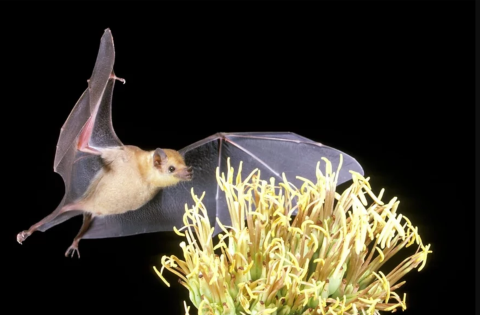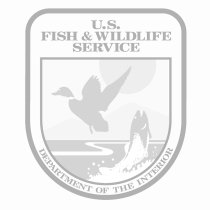Location
States
ArizonaEcosystem
Desert, ForestIntroduction
The lesser long-nosed bat (Leptonycteris curasoae yerbabuenae) and the federally-endangered Mexican long-tongued bat (Choeronycteris mexicana) depend on the flowers and nectar of agave (Agave spp.) as a food source when migrating, and while roosting in caves in the Southwestern United States and Northern Mexico. These nectarivorous bats and agave mutually benefit each other. The bats feed on flowering agaves for sustenance along their annual migration from Sonora, Mexico to Arizona. Concurrently, while feeding, the bats transfer pollen from plant to plant, supporting a genetically diverse, healthy agave population. Both species of bat suffer from the decline in agave caused by urban development in Arizona. Additionally, the rise in popularity of bacanora, a distilled beverage made from Sonoran agaves, has greatly reduced the number of agaves reaching flowering age in Mexico. For bacanora production, agaves are harvested before they flower, thereby depriving bats of a vital food source.
In response, Bat Conservation International (BCI) collaborated with both the Borderlands Restoration Network (BRN) in Patagonia, Arizona, and Colectivo Sonora Silvestre in Sonora, Mexico, to fund work that increased the number of flowering agaves along the migratory route of these nectavorious migratory bats. In Arizona, BRN collects pollinated agave seeds in the wild for propagation at their nursery before they are planted in the wild. They also complete baseline monitoring of agave populations. In Mexico, Colectivo Sonora Silvestre has been working with the bacanora industry to foster sustainability. Unfortunately, planting agaves and outreach were not enough to combat the effects of the skyrocketing popularity of bacanora and associated harvest of agaves planted in the wild. The BCI funding allowed both organizations to develop locally appropriate responses to this cross-border issue, increase the number of flowering agaves throughout the landscape, and raise awareness of the important relationship between bats and agave through community engagement. In part due to partnerships like this one, the lesser long-nosed bat was recently removed from the U.S endangered species list. This is the first time a bat species has been removed from the list due to population recovery—a powerful demonstration of effective conservation measures.
Key Issues Addressed
Depleted agave populations along migration routes and near roosting sites result in starvation of bats. Agaves are important to bats as a major food source throughout their range, and bats are also critical for agave. Without bats, agave seed counts drop to 1/3000th of normal, perpetuating the harmful cycle of agave decline and harming both species. Bacanora producers harvest agave plants before they flower as the agave’s sugar content is highest before they bloom. This practice leaves no nectar for bats and deprives the flowers of pollination, reducing the genetic diversity of the agave population.
Agave populations are declining across the migratory pathway of these bats, but there is limited information about rates of decline, locations of plants, and overall abundance. Agave reductions stemming from bacanora production in Mexico can be observed clearly. In Arizona, the relationship between urban development and loss of agaves is harder to visualize. This information is necessary to better understand agave decline and inform conservation efforts. In addition to this lack of data, there is a lack of public awareness regarding the relationship between bats and agave. Bats are often undervalued, with many people unaware of the vital ecosystem services they perform, such as pollinating agaves. Bats and agaves are thought of as separate, unrelated entities, despite being interdependent.
Binational conservation needs further complicate restoration work, with cross-border communication and funding often difficult to achieve. Communication is complicated due to linguistic and national borders. In response, collaborators from both organizations developed nuanced, locally appropriate responses to the distinct challenges of agave destruction due to urban development in the United States and overharvest for bacanora production in Mexico.
Project Goals
- Protect and enhance existing agave habitats to encourage the growth of new agave stands that support bat populations: Planting thousands of agave throughout the migratory corridor is key to supporting bat populations and increasing agave abundance
- Increase the amount of data available on overall agave abundance throughout the corridor to better demonstrate and understand the decline in agaves
- Raise awareness within both the general public and bacanora producers about the connection between bats and agave through outreach at community events, bacanora industry conferences, and individual households
- Increase collaboration between restoration initiatives in Arizona and Sonora by sharing best practices, communicating constantly, and coordinating locally appropriate responses to key challenges
- Foster sustainable agave harvest practices with an industry-supported sustainable agave label for bacanora production to increase the amount of agaves that flower within farmers’ fields
Project Highlights
Bacanora and Bats: The bacanora people drink and the nectar that bats depend on come from agaves. Restoring agaves is a win-win solution that benefits both humans and bats.
- Increasing Agave Populations: Borderlands Restoration Network runs a substantial agave planting and monitoring program to restore the agave population and in turn support the bat population. Through this initiative, they planted 1,750 agave seeds between 2020 and 2021 and transplanted unwanted agaves from private properties. The team at BRN harvests seeds from pollinated, high-elevation agaves and brings them back to their headquarters to propagate at their nursery and plant within the nectar corridor. In Sonora and Arizona, they planted agaves on rural homeowners’ properties, rather than in the wild, where they are watered and monitored to ensure a bloom.
- Improved Public Perception: Addressing the lack of public knowledge about the relationship between bats and agave is vital to restoring their ecosystem. BRN and Collectivo Sonora Silvestre table at community events to explain the bat-agave relationship to broad audiences. Additionally, Colectivo Sonora Silvestre met bacanora producers at conferences or at their farms, changing their outreach strategy depending on the individual producer. After outreach, members of the public and bacanora producers leave with a better understanding of the interconnection between bats and agave.
- Cross Border Collaboration: The Colorado State University Salazar Center awarded the $100,00 Connectivity Challenge prize to BRN. This money will help fund the Bacanora for Bats: Binational Conservation and Sustainable Agave Spirits Initiative. Roughly half of the prize will be spent in the U.S. with the other half sent to Mexico. The money will be used to continue support for locally appropriate responses to declining agave populations and reduce the negative effect this has on nectarivorous bats.
- Sustainable Agave Label for Bacanora Producers: Currently, Colectivo Sonora Silvestre are in the process of developing a sustainable agave label for businessesto encourage bacanora producers to harvest sustainably while benefiting both their product and the delicate local ecosystem of the Sonoran Desert. An example of a requirement under this label is that producers must allow 1% of agaves in their field to flower, thus allowing bats to feed on and pollinate their agaves.
Lessons Learned
A one-size-fits-all approach across borders was insufficient at tackling the issue of declining agave populations. For instance, while planting agaves worked for restoring agave populations in Arizona, this strategy did not have the same success rate in Sonora due to overharvesting of wild agaves for bacanora production. Due to this, Colectivo Sonora Silvestre and BRN shifted to planting agaves on rural homeowners’ properties to ensure proper watering and monitoring of newly planted agaves so that they could reach flowering age.
For bacanora producers to participate in a sustainable label program, the requirements must be achievable and the value of letting some agave flower must be communicated. Past sustainability efforts failed because they were formulated with high standards, such as a 5% bloom quota, that were too difficult for bacanora producers to achieve. Additionally, a sustainable label marketed as a value enhancer for their product helped entice bacanora producers into participating. Colectivo Sonora Silvestre established rapport with the Bacanora Regulatory Council and explained the bat and agave relationship in a way that landed with producers: genetic diversity to increase the resilience of agave crops. By explaining that genetic diversity and disease resilience increases when bats pollinate flowering agaves, bacanora producers better understood that a more sustainable agave crop could benefit their production.
Lastly, this project highlights the importance of bi-national communication and coordination between organizations in the United States and Mexico for species with migration corridors that span two countries. There is a lack of funding for conservation projects in Mexico and the importance of collaborating with U.S. organizations to fill critical funding gaps is highlighted through this project. Collaborative grant writing helped earn this project an $100,000 prize for the connectivity challenge. Further, agaves propagated at the nursery in Arizona can be transported to Mexico for dispersal in rural areas near bat roosts.
Next Steps
- Continue planting agaves that reach flowering age on both sides of the border
- Increase data collection and monitoring efforts to better inform conservation efforts and help establish a more concrete link between urban development and agave habitat destruction
- Continue development of a sustainable agave label for businesses through continued outreach to bacanora producers in Sonora
- Maintain collaboration and communication between organizations across borders
Funding Partners
- Bat Conservation International (BCI)
- Colorado State University Salazar Center’s Connectivity Challenge Grant
Resources
- Agave + Bats: A Vital Relationship Youtube video
- Restoring Agave for Nectar-feeding Bats
- BCN Bats & Agave Project
- Boosting Bats by Restoring Mexico’s Agave
- Borderlands Wins Big for Bats and Bacanora
- Podcast Episode: Sonoran Government Supports Sustainable Bacanora Distinction To Protect Bats, Agave
- Borderlands Restoration Network blog post on agaves
- First Bat Removed From U.S. Endangered Species List
- Colectivo Sonora Silvestre
Contacts
- Francesca Claverie, Native Plant Program Manager, Borderlands Restoration Network: afclaverie@borderlandsrestoration.org
- Valeria Cañedo, Co-director, Colectivo Sonora Silvestre: valeriacanedom@hotmail.com
- Lea Ibarra, Co-director, Colectivo Sonora Silvestre: leaibarra96@gmail.com
Cart Lead Author
Marty Salamone, CART Student Writer, Georgetown University: mls383@georgetown.edu
Suggested Citation
Salamone, M., Canedo, V., Ibarra, L., and Claverie, F. (2022). “Restoring Agave for Migratory Bats in the United States-Mexico Borderlands.” CART. Retrieved from https://www.fws.gov/project/restoring-agave-migratory-bats.




